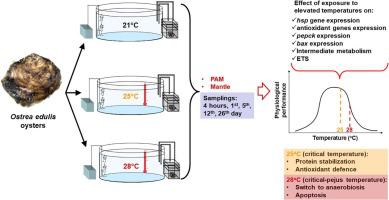Comparative Biochemistry and Physiology B: Biochemistry & Molecular Biology ( IF 2.2 ) Pub Date : 2024-01-13 , DOI: 10.1016/j.cbpb.2024.110943 Ioannis Georgoulis , Dimitrios K. Papadopoulos , Athanasios Lattos , Basile Michaelidis , Konstantinos Feidantsis , Ioannis A. Giantsis

|
Bivalves are among the marine organisms most influenced by climate change. Despite the flat oyster's Ostrea edulis high economic value, its culture is developed on a very small scale, since this species possesses a strong susceptibility to abiotic stressors. Due to climate change, temperature is one of the most critical environmental parameters for the welfare of the Mediterranean basin's marine inhabitants. The present study's purpose was to investigate the physiological performance of the Mediterranean's native O. edulis as it faces exposure to different temperatures. Since juveniles are more susceptible to abiotic stressors, this experimental procedure was focused on young individuals. The seawater temperatures studied included a standard control temperature of 21 °C (often observed in several marine areas throughout the Mediterranean), as well as increased seawater temperatures of 25 °C and 28 °C, occasionally occurring in shallow Mediterranean waters inhabited by bivalve spat. These were selected since the tissues of O. edulis becomes partly anaerobic in temperatures exceeding 26 °C, while cardiac dysfunction (arrhythmia) emerges at 28 °C. The results demonstrate that temperatures above 25 °C trigger both the transcriptional upregulation of hsp70 and hsp90, and the antioxidant genes Cu/Zn sod and catalase. Enhancement of thermal tolerance and increased defense against increased ROS production during thermal stress, were observed. As the intensity and duration of thermal stress increases, apoptotic damage may also occur. The increased oxidative and thermal stress incurred at the highest temperature of 28 °C, seemed to trigger the switch from aerobic to anaerobic metabolism, reflected by higher pepck mRNA expressions and lower ETS activity.
中文翻译:

海水温度升高会引发牡蛎的热、氧化和代谢反应,导致厌氧
双壳类是受气候变化影响最严重的海洋生物之一。尽管扁牡蛎的美味牡蛎具有很高的经济价值,但其养殖规模非常小,因为该物种对非生物胁迫具有很强的敏感性。由于气候变化,温度是地中海盆地海洋居民福祉最关键的环境参数之一。本研究的目的是调查地中海本地美味玉米在暴露于不同温度时的生理表现。由于青少年更容易受到非生物应激源的影响,因此该实验程序主要针对青少年。研究的海水温度包括 21°C 的标准控制温度(经常在整个地中海的几个海洋区域观察到),以及 25°C 和 28°C 的升高海水温度,偶尔发生在双壳贝类栖息的地中海浅水区。选择这些是因为,当温度超过 26 °C 时,美味野生果蝇的组织会变得部分厌氧,而在 28 °C 时会出现心脏功能障碍(心律失常)。结果表明,25°C 以上的温度会触发hsp70和hsp90的转录上调,以及抗氧化基因Cu/Zn sod和过氧化氢酶。观察到热耐受性增强,并增强了对热应激期间 ROS 产生增加的防御能力。随着热应激强度和持续时间的增加,也可能发生细胞凋亡损伤。最高温度 28°C 时产生的氧化和热应激增加,似乎触发了有氧代谢向无氧代谢的转变,这反映在较高的pepck mRNA 表达和较低的 ETS 活性上。



























 京公网安备 11010802027423号
京公网安备 11010802027423号